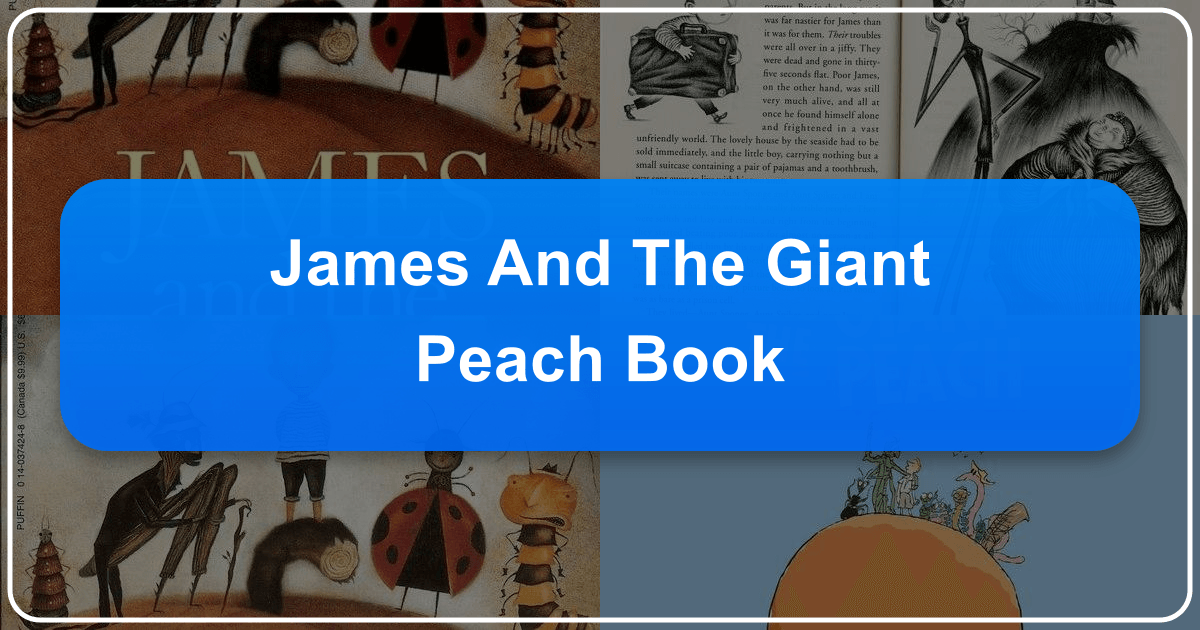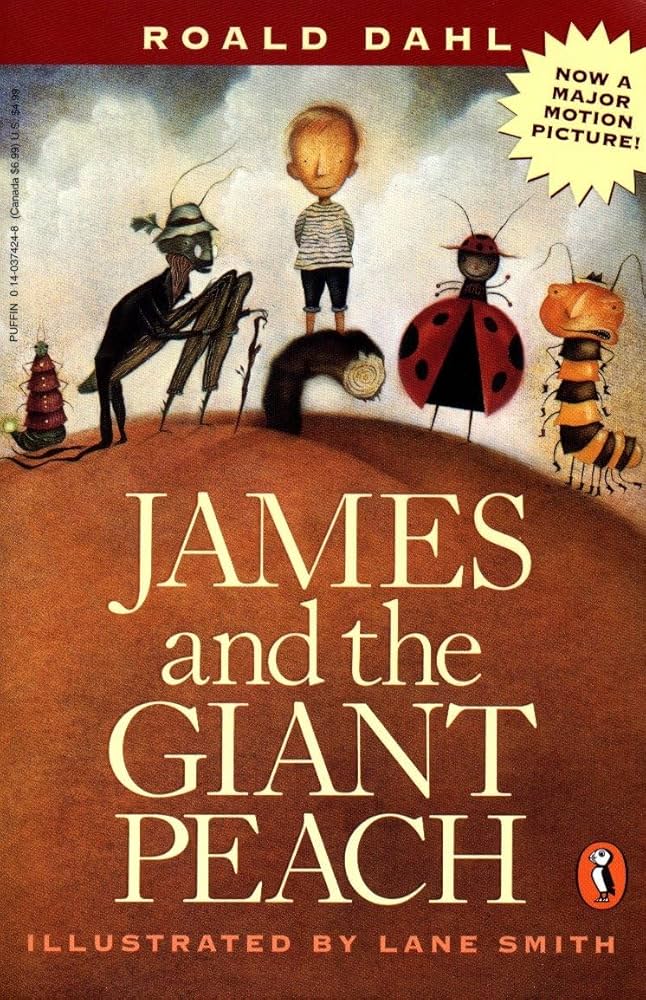*James and the Giant Peach*: A Comprehensive Exploration

Roald Dahl’s James and the Giant Peach is a beloved children’s classic that continues to capture the imaginations of young readers across generations. This whimsical tale of an orphaned boy, his fantastical journey in a giant peach, and his unlikely friendships with oversized insects has earned its place as one of TIME Magazine’s 100 Best Fantasy Books of All Time. This in-depth exploration delves into the book’s various aspects, examining its genre, authorial style, educational value, and lasting cultural impact. We will analyze James and the Giant Peach through the lenses of several key areas: its classification within children’s literature, the unique contributions of its author and illustrator, the life lessons it imparts, and its enduring influence on popular culture.
1. Genre and Literary Classification

James and the Giant Peach seamlessly blends elements of several genres, making it a rich and engaging read for children. Primarily, it falls under the category of children’s fantasy literature. The central premise—a giant peach housing talking insects that transport a boy on a fantastical voyage—is inherently fantastical and defies the boundaries of reality. This fantastical element is interwoven with elements of adventure, as James and his insect companions face perilous challenges during their journey across the Atlantic Ocean. They encounter dangers like sharks and Cloud-Men, adding thrills and excitement to the narrative. Further, the story incorporates elements of coming-of-age storytelling, following James’s personal growth as he confronts his traumatic past and learns to navigate new friendships and challenges. The narrative’s blend of fantastical elements, adventure, and character development makes it an ideal entry point for young readers to explore the wonders of imaginative fiction. The book also has a touch of whimsy and humor, typical of Dahl’s style, making it both thrilling and entertaining.

1.1. Comparison with other Children’s Classics
The success of James and the Giant Peach lies, in part, in its ability to evoke the spirit of classic children’s literature while maintaining a distinctly modern sensibility. It shares similarities with fairy tales, possessing clear-cut good versus evil characters (James versus his aunts), a magical element (the crystals), and a satisfying happy ending. However, unlike traditional fairy tales, Dahl’s narrative doesn’t shy away from darker themes like loss and grief, tackling mature subjects with sensitivity and relatability. This combination of classic archetypes and modern thematic depth helps the book resonate with both children and adults.
2. Author and Illustrator: Roald Dahl and Quentin Blake
The enduring appeal of James and the Giant Peach is inseparable from the talents of its creator, Roald Dahl, and illustrator, Quentin Blake.

2.1. Roald Dahl’s Unique Writing Style
Roald Dahl was renowned for his distinctive writing style, characterized by its imaginative flair, dark humor, and memorable characters. His stories often feature eccentric and often cruel adults juxtaposed against resourceful and brave children who ultimately triumph. James and the Giant Peach is no exception, with the despicable Aunt Sponge and Aunt Spiker providing a stark contrast to James’s resilience and the quirky personalities of his insect companions. Dahl masterfully blends elements of the absurd and the relatable, creating a narrative that is both thrilling and thought-provoking. His use of vivid descriptions and imaginative storytelling makes the world of the giant peach feel incredibly real and engaging, despite its inherent fantastical nature. This ability to balance dark humor with genuine emotion makes his characters simultaneously frightening and lovable.
2.2. Quentin Blake’s Illustrative Contribution
Quentin Blake’s illustrations complement Dahl’s writing perfectly. His distinctive style, known for its expressive characters and bold lines, perfectly captures the whimsical and slightly unsettling nature of the story. His illustrations of the oversized insects, particularly the Centipede, are both funny and slightly grotesque, perfectly embodying the unique blend of humor and darkness characteristic of Dahl’s writing. Blake’s illustrations don’t just provide visual accompaniment to the text but actively contribute to the overall tone and mood of the book. They add a layer of humor and visual appeal, enhancing the reader’s enjoyment and understanding of the story.
3. Educational Value and Life Lessons
Beyond its entertainment value, James and the Giant Peach offers several significant educational benefits and imparts valuable life lessons.
3.1. Themes of Loss, Grief, and Resilience
The book poignantly explores the themes of loss, grief, and resilience. James’s early experience of losing his parents shapes his character and his interactions with the world. The narrative shows how he overcomes his sadness and finds strength through friendship and unexpected opportunities. This relatable portrayal of grief allows children to confront their own feelings of loss and understand the importance of seeking support during challenging times. The story demonstrates the power of resilience and the ability to overcome adversity.
3.2. Exploration of Friendship and Teamwork
James’s journey in the giant peach highlights the importance of friendship and teamwork. His relationships with the diverse group of insects teach him valuable lessons about cooperation, compromise, and the strength found in unity. Each insect character possesses unique skills and perspectives, and their collaborative efforts are crucial to navigating the dangers and challenges they face. The story emphasizes the power of diverse perspectives and the importance of working together to achieve shared goals.
3.3. Developing Reading Habits and Comprehension
The book’s engaging narrative and accessible language make it an ideal choice for developing reading skills and comprehension in young children. The vivid imagery and intriguing plot keep young readers hooked, encouraging them to continue reading and improving their literacy skills. The story also provides opportunities for discussion and critical thinking, allowing educators and parents to engage children in conversations about the book’s themes and characters.
4. Cultural Impact and Adaptations
James and the Giant Peach has had a profound cultural impact, extending beyond its role as a beloved children’s book.
4.1. Literary Influence
James and the Giant Peach has influenced numerous subsequent works in children’s literature, impacting the way authors portray dark themes in children’s books. Dahl’s willingness to tackle challenging subjects like death and loneliness with sensitivity and humor paved the way for more complex and nuanced narratives in children’s literature. The book’s use of vivid imagery and imaginative storytelling has also served as inspiration for many other children’s authors.
4.2. Film and Stage Adaptations
The story has been adapted into several successful films and stage productions, further cementing its place in popular culture. These adaptations have introduced James and the Giant Peach to new audiences, ensuring its continuing relevance. The different interpretations of the story through various media showcase the adaptability and enduring power of Dahl’s original narrative.
4.3. Awards and Recognition
James and the Giant Peach has received numerous awards and accolades, validating its literary merit and cultural significance. These awards reflect its impact on readers and its influence on the broader literary landscape. The continued recognition of the book illustrates its place as a significant contribution to children’s literature and its lasting appeal for multiple generations.
5. Availability and Accessibility
James and the Giant Peach is widely available in various formats, including paperback, hardcover, ebook, and audiobook. This accessibility ensures its availability to diverse audiences, and allows children to experience the story in a way that best suits their learning preferences. The book’s accessibility reflects its importance in providing rich storytelling to a large readership and continuing to promote childhood literacy.
In conclusion, James and the Giant Peach stands as a remarkable achievement in children’s literature. Its blend of genres, masterful storytelling, educational value, and lasting cultural impact ensures its continued relevance and appeal for generations to come. From its fantastical adventure to its poignant exploration of human emotions, James and the Giant Peach remains a timeless classic, deserving of its place amongst the greatest works of children’s literature.